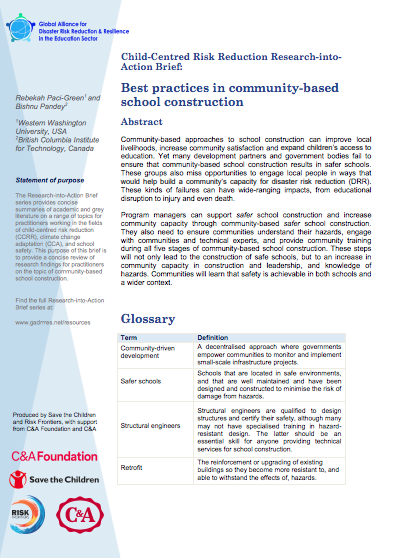
Research-into-Action Brief: Best Practices in Community-Based School Construction
Publication year:
2018
English
Format:
pdf (312.6 KiB)
Publisher:
GADRRRES, Global Alliance for Disaster Risk Reduction and Resilience in the Education Sector
This brief explores how community-based approaches to school construction can improve local livelihoods, increase community satisfaction and expand children’s access to education. Yet many development partners and government bodies fail to ensure that community-based school construction results in safer schools. These groups also miss opportunities to engage local people in ways that would help build a community’s capacity for disaster risk reduction. These kinds of failures can have wide-ranging impacts, from educational disruption to injury and even death. Program managers can support safer school construction and increase community capacity through community-based safer school construction. They also need to ensure communities understand their hazards, engage with communities and technical experts, and provide community training during all five stages of community-based school construction. These steps will not only lead to the construction of safe schools, but an increase in community capacity in construction and leadership, and knowledge of hazards, too. Communities will learn that safety is achievable, not only in terms of schools, but in a wider context as well. This brief is part of a series.
The Research-into-Action Brief series includes two main tools:
1. Research-into-Action Briefs and Summaries
2. Shared Bibliography on Zotero: https://www.zotero.org/groups/1857446/ccrr__css
These tools are for practitioners working in fields of child-centred risk reduction (CCRR), climate change adaptation (CCA) and school safety. The briefs and summaries are also intended to be used for training and capacity development for practitioners and partners, including government.
The briefs provide a concise review of research findings on a range of topics which have been selected by practitioners. The briefs have a focus on how the research findings could be (or have been) applied in practice. Each brief is 6-10 pages long, and generally contains a glossary, literature review, case study or examples, practical applications, key readings, and follow-up questions.
The summaries are two pages long and provide a quick snapshot of the main messages from the briefs. These can be used to both promote the full Research-into-Action Brief, to provide a quick overview of the topic, or to promote the use of research.
Read full abstract
Authors
View & Download
Document information
Publisher
Authors
Format
Rights
© Author/Publisher
Found a mistake? Help us improve!
If you have noticed a document assigned to the wrong author or any other inaccuracies, let us know! Your feedback helps us keep our data accurate and useful for everyone.
Share
Link
